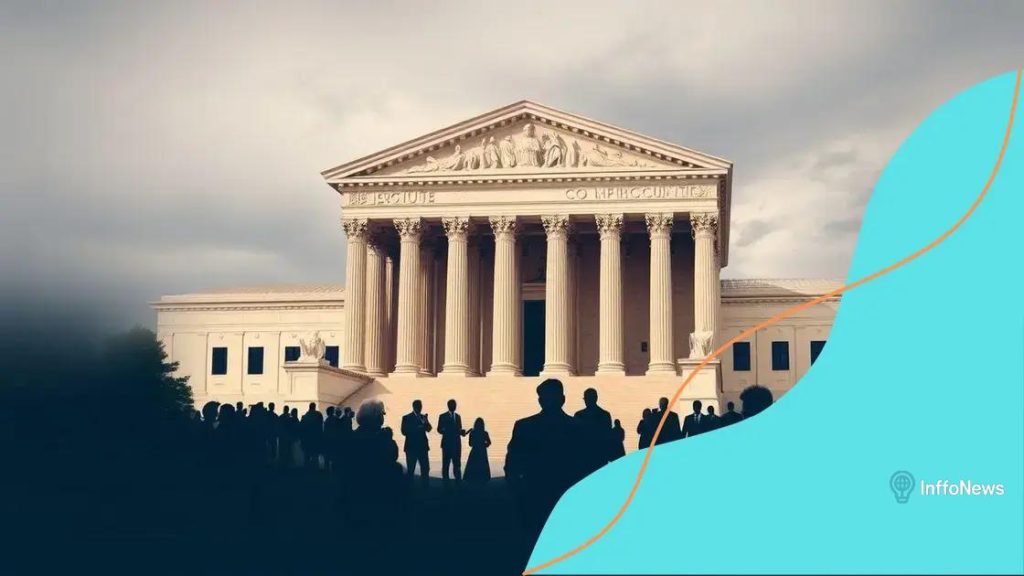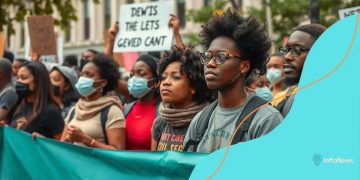Analysis of Supreme Court decisions: what you need to know

Anúncios
The analysis of Supreme Court decisions reveals their significant impact on American laws, rights, and societal norms, shaping how individuals experience justice and equality in their daily lives.
Analysis of Supreme Court decisions reveals how judicial rulings affect our rights and society. Have you ever wondered how these decisions influence your daily life?
Anúncios
Understanding the role of the Supreme Court
The Supreme Court plays a crucial role in the United States judicial system. It serves as the highest court, ensuring that laws align with the Constitution. Understanding its role is essential for grasping how justice is served in our democracy.
What Does the Supreme Court Do?
The Supreme Court interprets laws and hears cases that may involve constitutional issues or significant legal questions. Its decisions can have nationwide effects, influencing laws and society at large.
- Reviews cases from lower courts
- Interprets the Constitution
- Sets legal precedents that lower courts follow
- Protects citizens’ rights and liberties
By reviewing cases, the Supreme Court can overturn or uphold decisions made by lower courts. This power helps maintain the rule of law and protect the rights of all citizens.
Anúncios
The Appointment of Justices
Supreme Court justices are appointed by the President and confirmed by the Senate. This process is crucial because justices serve for life, making their role significant in shaping the law over decades. The ideological stance of justices often influences their rulings, which can lead to major shifts in legal interpretation.
Understanding how justices are appointed can provide insights into the political landscape and its impact on judicial decisions. The balance of the Court can sway based on the political party in power, affecting how laws are interpreted.
Given the importance of the Supreme Court in upholding justice and balancing powers, being informed about its role can help citizens recognize how laws affect their daily lives. As each decision can set precedents, following the Court’s rulings is key to understanding American law.
Key cases that shaped legal precedents
Throughout history, several key cases have significantly shaped legal precedents in the United States. These landmark decisions have not only influenced the law but also defined the rights of individuals and the powers of government.
Brown v. Board of Education
This pivotal case in 1954 declared that racial segregation in public schools was unconstitutional. The Supreme Court’s ruling overturned the earlier decision in Plessy v. Ferguson, which had established the doctrine of “separate but equal.” Brown v. Board of Education was a crucial step toward civil rights, paving the way for future legislation against discrimination.
Miranda v. Arizona
In 1966, the Supreme Court ruled that individuals in police custody must be informed of their rights before being interrogated. This case established the famous “Miranda rights,” ensuring that suspects are aware of their right to remain silent and to have an attorney present. This ruling emphasizes the protection of individual rights during legal proceedings.
Roe v. Wade
The 1973 decision in Roe v. Wade recognized a woman’s legal right to abortion under the right to privacy. This case stirred nationwide debates about women’s rights and reproductive freedom. It is often cited in discussions about abortion laws and women’s health issues, highlighting the ongoing tensions between personal liberty and governmental regulation.
Obergefell v. Hodges
In 2015, this landmark case legalized same-sex marriage across the nation. The Supreme Court found that denying marriage licenses to same-sex couples violated the Constitution. Obergefell v. Hodges was a significant moment in the struggle for LGBTQ rights, reinforcing the idea that love and commitment should be honored for all citizens.
These cases demonstrate how the Supreme Court’s decisions can have profound implications for society. They not only reinterpret existing laws but also reflect societal values and evolve with changing times. Understanding these key rulings helps illustrate the dynamic nature of the law and its impact on everyday life.
How Supreme Court decisions impact everyday life

Supreme Court decisions have a significant impact on our everyday lives, shaping the laws and rights that govern us. These rulings can influence everything from education to personal freedoms, and understanding their effects is essential for every citizen.
Education and Equality
One major area affected by Supreme Court rulings is education. Cases like Brown v. Board of Education established the principle that racial segregation in schools is unconstitutional. This ruling opened doors for equal educational opportunities, affecting millions of students across the country.
- Ensures schools are accessible to all
- Promotes diversity in educational environments
- Sets standards for equitable treatment
Such decisions help shape a fair educational landscape, contributing to a more informed and inclusive society. As academic access improves, the community benefits from a more educated populace.
Personal Rights and Freedoms
Beyond education, Supreme Court decisions influence personal rights and freedoms. For instance, rulings on freedom of speech or privacy rights can determine what individuals are permitted to express publicly or how their private lives are protected. Landmark decisions, such as Roe v. Wade, have significant consequences for personal choices and healthcare.
These rulings establish the legal frameworks that protect individual liberties against governmental overreach. Understanding how these decisions affect day-to-day life empowers citizens to advocate for their rights.
Workplace and Economy
The Supreme Court also plays a crucial role in shaping workplace rights and economic policies. Cases concerning employment discrimination ensure that everyone has a fair chance in the workplace. These decisions promote equality and protect workers from unfair treatment.
- Legal protections against workplace discrimination
- Guidelines for employee benefits and rights
- Regulations to ensure safe working conditions
As a result, the workplace environment evolves, promoting fairness and justice for all workers. The implications of these laws reach far beyond the courtrooms, impacting daily routines, job security, and overall lifestyle.
In essence, decisions made by the Supreme Court weave through the fabric of American life. They dictate how we interact in society and define the rights we hold dear, making it critical to stay informed about these influential rulings.
The nomination process for Supreme Court justices
The nomination process for Supreme Court justices is a critical component of the American judicial system. This careful selection process ensures that only qualified individuals serve on the highest court in the land.
Presidential Nominations
When a vacancy arises on the Supreme Court, the President of the United States has the responsibility to nominate a candidate. This choice often reflects the President’s judicial philosophy and political beliefs. The nomination can greatly influence the direction of the Court, making it a significant political event.
Senate Confirmation
After the President submits a nomination, the next step involves the Senate, which has the power to confirm or reject the nominee. The Senate Judiciary Committee typically conducts hearings where the nominee answers questions about their qualifications and judicial outlook. This process allows senators to assess the nominee’s suitability and ideological leanings.
- Evaluation of the nominee’s qualifications
- Public hearings to gauge opinions
- Committee findings on the nominee’s background
- Full Senate vote for final confirmation
The committee’s report, along with public input and debates, ultimately informs the Senate’s vote. A simple majority is required for confirmation, which can lead to intense political maneuvering, especially if the Senate is closely divided.
Impact of the Nomination Process
The nomination of a Supreme Court justice is not just about filling a seat; it reflects larger societal values and directions. Successful nominees often serve for decades, making their impact on the law long-lasting. This process also highlights the importance of political dynamics as it can cause shifts in the balance of power within the Court and affect legal precedents.
Understanding this process is vital since the decisions made by the Court can influence many aspects of daily life, from rights and liberties to social policies. Each nomination sparks discussions about the future of the judiciary and the legal interpretation of laws in America.
Future trends in Supreme Court rulings
The future trends in Supreme Court rulings are shaping the legal landscape of the United States. As society evolves, the Court’s interpretations of laws and its decisions will likely reflect emerging values and priorities.
Influence of Technology
With the rise of technology, cases involving digital privacy, cybersecurity, and intellectual property are becoming increasingly significant. The Court will need to address how existing laws apply to new technologies and social media. As these issues arise, the rulings could redefine personal privacy rights and free speech in digital spaces.
- Cases addressing online data protection
- Regulations on social media content
- Intellectual property rights in the digital age
These technological advancements challenge the Court to interpret the Constitution in ways that align with contemporary life and concerns.
Ongoing Discussions Around Justice
Moreover, the national conversations about racial justice, equality, and health care could lead to significant rulings. The Supreme Court may tackle cases that test civil rights protections and health care legislation, shaping policies for years to come. Decisions on these matters can alter how laws are applied and understood in everyday situations.
As public opinion shifts regarding issues like same-sex marriage, abortion rights, and police accountability, the Court may revisit past rulings or establish new precedents. Each decision can ignite debate and motivate changes in legislation and social norms.
Political Dynamics
The political climate also plays a crucial role in shaping future Supreme Court trends. The composition of the Court can sway its rulings based on the justices’ philosophies. A bench that leans more conservatively or liberally can alter judicial outcomes significantly, influencing American life and policy.Understanding these dynamics is essential for predicting how the Court might act in coming years.
As new cases arise and societal norms continue to shift, staying informed about the Court’s direction will be vital. The impact of future rulings will resonate through legal systems and everyday experiences, making awareness crucial for all citizens.
FAQ – Frequently Asked Questions about Supreme Court Decisions
What is the role of the Supreme Court in the U.S. government?
The Supreme Court is the highest court in the U.S. and has the authority to interpret laws and ensure they align with the Constitution, impacting citizen rights and policies.
How does the nomination process for justices work?
The President nominates potential justices, who are then vetted and confirmed by the Senate through hearings and votes, shaping the Court’s ideological balance.
Why are Supreme Court decisions important for everyday life?
Supreme Court decisions can influence laws that affect education, civil rights, and personal freedoms, shaping how we live and interact in society.
What future trends could impact Supreme Court rulings?
Emerging issues like technology, civil rights discussions, and changing political landscapes may lead to significant rulings that redefine laws and rights in the future.





